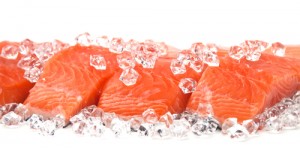If your family is like mine, then summer and sandwiches were meant for one another. Whether it’s a PBJ and a glass of milk on the deck for a quick lunch or a grilled cheese on a rainy day, a sandwich hits the spot. This summer if you find yourself wondering what kind of sandwich to have next, try this salmon sub.

It begins with Morey’s Garlic Cracked Pepper Atlantic Salmon. Simply place the frozen fillets in what I call “aluminum foil boats” along with all the savory marinade that they’re packaged in. Put them on the grill according to the package directions. While they grill in bubbling goodness, prepare your other simple ingredients, which include Swiss cheese, fresh spinach, sliced ripe tomatoes, thinly sliced Vidalia onion and shaved carrots. All those veggies are of course chosen for their wonderful flavor – but also for the nice mix of pleasing color that they bring to your meal event.
Now this part is important, because a great sandwich needs great bread. I recommend using soft and chewy focaccia rolls for these subs. Spread a thin layer of butter or mayo (your choice) on the open rolls and sprinkle a little garlic salt on that. For the last few minutes of the salmon bake time, put the rolls on the grill too, so that flavor melts in and the edges of the rolls get a slight “crisp” to them.
Lastly, build your sandwiches from the bottom up in this order: bottom roll, salmon, onion, spinach, carrots, tomato, cheese and top roll. If you’re a wine lover, a buttery chardonnay is a great pairing. Or for beer connoisseurs, try a hoppy pale ale alongside your submarine. Enjoy, and have a happy summer!
You may have heard that Wild Alaskan salmon is extremely nutritious, high in not only Omega 3s, but also vitamins A and D, and minerals like zinc, selenium, calcium, phosphorus, and iron. These nutrients, found in many kinds of seafood, are beneficial to many parts of the human body; eyes, muscles, and metabolism. They may even help prevent heart disease! However, many people still have some questions about whether Wild Alaskan salmon, one of several salmon products, is a good seafood option.
 Is Wild Alaskan salmon sustainable? The answer is a resounding yes! Not only is Alaskan salmon low in contaminants and full of nutrition, it is also caught with gear that does very little damage to the environment. Considered a “Best Choice” fish by Seafood Watch, it is currently certified as sustainable by the Marine Stewardship Council and it carries an independent, third party FAO-Based Responsible Fisheries Management Certification.
Is Wild Alaskan salmon sustainable? The answer is a resounding yes! Not only is Alaskan salmon low in contaminants and full of nutrition, it is also caught with gear that does very little damage to the environment. Considered a “Best Choice” fish by Seafood Watch, it is currently certified as sustainable by the Marine Stewardship Council and it carries an independent, third party FAO-Based Responsible Fisheries Management Certification.
- How can Wild Alaskan salmon be fresh, if it is shipped all the way from Alaska? Some salmon is flash frozen at the peak of freshness, to seal in many vital nutrients. Salmon sold in fresh form, during the fresh salmon season, is flown from Alaska on a daily basis. This product arrives to market more quickly than almost any other protein!
- What are the different salmon types? There are five species of Wild Alaskan salmon:
- King (Chinook) is the largest of the salmon, with flaky flesh and succulent flavor. Kings have the highest oil content of all the salmon varieties. They are usually sold as whole fish, fillets or steaks.
- Sockeye (Red) is the second most abundant type of Alaskan salmon, and it is prized for its rich flavor. Consumers are beginning to discover the value of this delicious fish.
- Coho (Silver) has a distinctive red-orange color, and an excellent firmness. Similar to King salmon in texture, Coho makes an excellent choice for steaks and fillets.
- Keta (Chum) has a delicate flavor, and lower oil content than many other types of salmon. Usually available in steak and fillet forms, Keta is excellent for marinating and smoking in particular.
- Pink is the most abundant salmon species, distinguished by its light, rosy pink color. With a tender, delicate flavor, pink salmon is typically sold in canned or frozen form.
- Why is wild salmon red? Wild salmon gets its color from eating a diet of krill. Because the diet of wild salmon can vary, the color can also vary.
- Why is Wild Alaskan salmon so nutritious? Salmon need fresh water in which to spawn. During the salmon life cycle, they travel far out into the ocean, where food is dense with nutrition. The salmon stock up on food in the ocean, because they will not eat after they have returned to fresh water to complete their spawning cycle. Therefore, salmon heading inland from the ocean are full of fats and nutrients, making them tasty and nutritious.
Are you looking for ways to put more salmon on your family’s dinner table? For seventy-five years, Morey’s Seafood has been delivering fresh, high quality, easy to prepare fish to retailers and restaurants across the nation. For more information, visit the website or connect with the online community on Facebook and Twitter.
